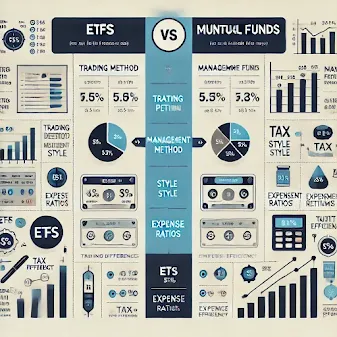Introduction
Investing is one of the most effective ways to build long-term wealth, and two of the most popular investment vehicles are Exchange-Traded Funds (ETFs) and Mutual Funds. Both offer diversification, professional management, and access to a variety of assets, but they operate differently. Understanding these differences is essential for making the right investment choices.
In this comprehensive guide, we’ll explore:
✅ What ETFs and mutual funds are
✅ Key differences between them
✅ Pros and cons of each investment type
✅ Which option is better for different investors
✅ Tips for choosing the right investment vehicle
By the end of this article, you'll have a clear understanding of which option suits your investment strategy best.
1. What Are ETFs and Mutual Funds?
A. What is an Exchange-Traded Fund (ETF)?
An Exchange-Traded Fund (ETF) is a type of investment fund that holds a collection of assets such as stocks, bonds, or commodities. ETFs are designed to track an index, sector, or asset class and are traded on stock exchanges like individual stocks.
Key Characteristics of ETFs:
✔ Traded throughout the day – Buy and sell ETFs at market prices anytime.
✔ Passive or active management – Most ETFs track an index, but some are actively managed.
✔ Lower expense ratios – Generally cheaper than mutual funds.
✔ Tax-efficient structure – Reduces taxable capital gains compared to mutual funds.
B. What is a Mutual Fund?
A Mutual Fund is an investment vehicle that pools money from multiple investors to invest in a diversified portfolio of stocks, bonds, or other assets. Unlike ETFs, mutual funds are bought and sold at the end-of-day Net Asset Value (NAV) price.
Key Characteristics of Mutual Funds:
✔ Bought and sold at NAV – Orders are processed only at market close.
✔ Typically actively managed – A professional fund manager makes investment decisions.
✔ May require a minimum investment – Some funds have entry requirements.
✔ Higher expense ratios – Active management costs more than ETFs.
2. Key Differences Between ETFs and Mutual Funds
| Feature | ETFs | Mutual Funds |
|---|---|---|
| Trading Method | Traded on stock exchanges all day | Bought/Sold at NAV at market close |
| Pricing | Prices fluctuate like stocks | Price determined at the end of the day |
| Management Style | Mostly passive, some active | Mostly active, some passive |
| Expense Ratios | Generally lower | Generally higher |
| Tax Efficiency | More tax-efficient | Less tax-efficient |
| Minimum Investment | No minimum | Often requires a minimum investment |
| Transaction Fees | Brokerage fees may apply | No trading fees, but some funds charge sales loads |
3. Advantages and Disadvantages of ETFs
✅ Advantages of ETFs:
✔ Lower Expense Ratios – ETFs have lower fees, making them cost-effective.
✔ Tax Efficiency – ETFs typically generate fewer taxable capital gains.
✔ Liquidity & Flexibility – ETFs trade like stocks, allowing for real-time strategies.
✔ Diversification – Many ETFs track indexes, offering broad market exposure.
❌ Disadvantages of ETFs:
✖ Brokerage Fees – Some ETFs charge transaction fees, depending on the broker.
✖ Price Volatility – Since ETFs trade like stocks, prices fluctuate intraday.
✖ Market Spread Risks – The bid-ask spread can impact ETF pricing.
4. Advantages and Disadvantages of Mutual Funds
✅ Advantages of Mutual Funds:
✔ Professional Management – Fund managers actively manage portfolios.
✔ Ideal for Long-Term Investors – Best for those who prefer a hands-off approach.
✔ Automatic Investment Plans – Many funds allow dollar-cost averaging strategies.
✔ No Trading Commissions – Unlike ETFs, mutual funds don’t have brokerage fees.
❌ Disadvantages of Mutual Funds:
✖ Higher Fees – Actively managed mutual funds often have higher expense ratios.
✖ Less Tax Efficiency – Investors may face capital gains taxes even without selling shares.
✖ Limited Trading Flexibility – Mutual funds don’t allow intraday trading.
✖ Potential Sales Charges – Some funds have front-end or back-end load fees.
5. ETFs vs. Mutual Funds: Which One is Right for You?
ETFs Are Better For:
✅ Investors who prefer lower fees – ETFs usually have lower expense ratios.
✅ Traders who want flexibility – ETFs can be bought/sold anytime during trading hours.
✅ Tax-conscious investors – ETFs are more tax-efficient than mutual funds.
✅ Passive investors – ETFs track indexes, making them ideal for long-term investing.
Mutual Funds Are Better For:
✅ Long-term investors – Hands-off investing with professional management.
✅ Investors who don’t trade frequently – Ideal for buy-and-hold strategies.
✅ Automatic investing plans – Mutual funds allow dollar-cost averaging.
✅ Those who prefer active management – Fund managers make investment decisions.
6. How to Choose the Right Investment for You
Key Factors to Consider:
✔ Investment Goals – Are you looking for growth, income, or diversification?
✔ Cost Considerations – ETFs usually have lower fees, but mutual funds might be more cost-effective for long-term investors.
✔ Tax Efficiency – If minimizing taxes is a priority, ETFs are a better choice.
✔ Liquidity Needs – If you need quick access to funds, ETFs offer better flexibility.
✔ Active vs. Passive Management – Prefer professional oversight? Choose mutual funds.
7. Conclusion
Both ETFs and mutual funds provide diversification and access to broad markets, but the best choice depends on your financial goals, risk tolerance, and investment style.
📌 Choose ETFs if you want lower costs, flexibility, and tax efficiency.
📌 Choose mutual funds if you prefer professional management and long-term stability.
Before making a decision, analyze your investment strategy, compare fees, and consult a financial advisor if needed.
💡 Final Thought: Whether you choose ETFs or mutual funds, the key to successful investing is staying consistent, diversifying your portfolio, and maintaining a long-term perspective. 🚀
